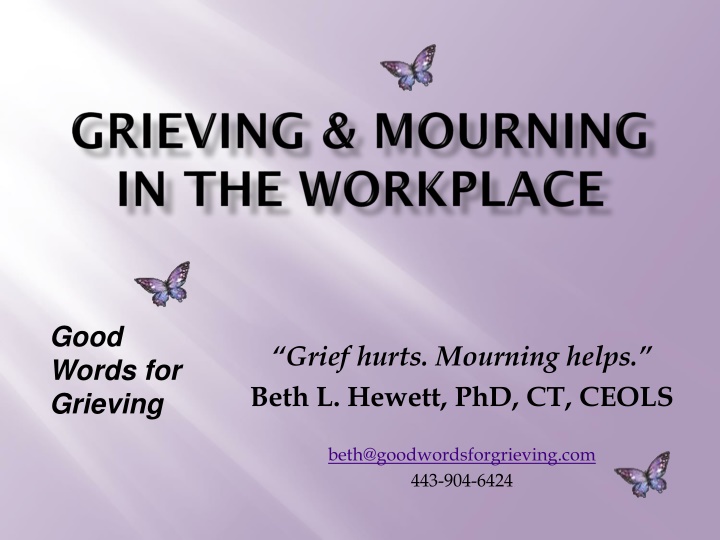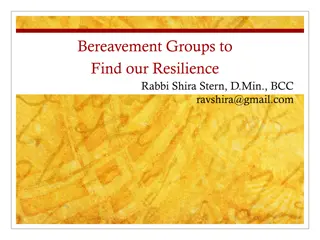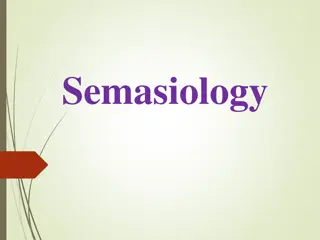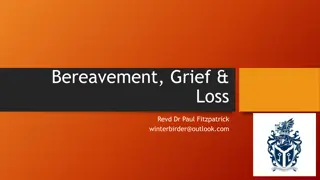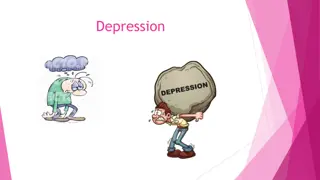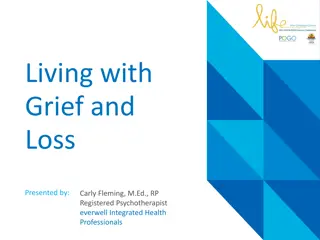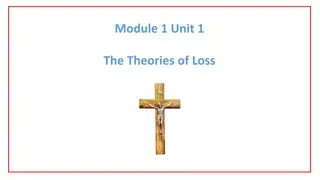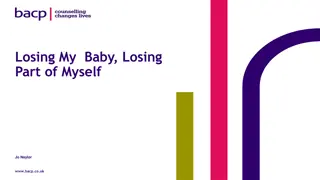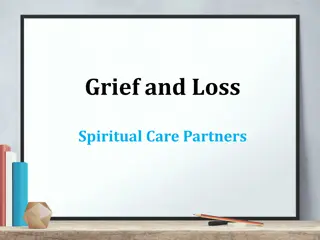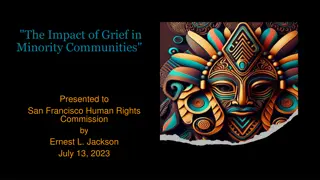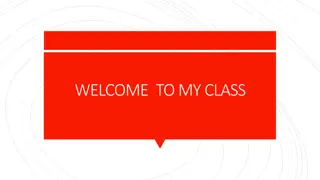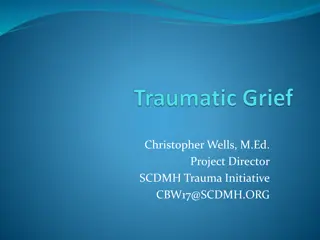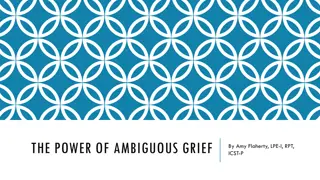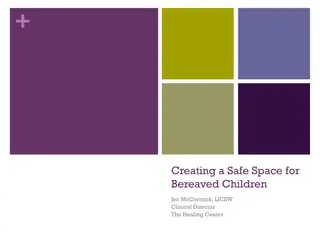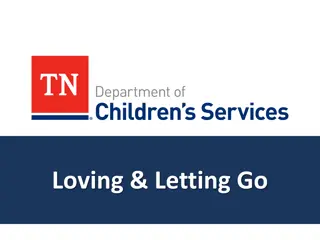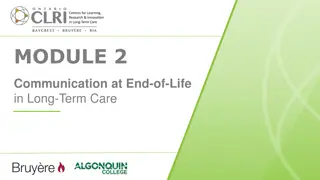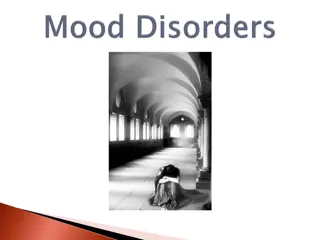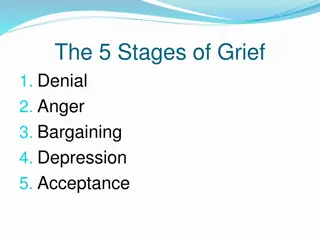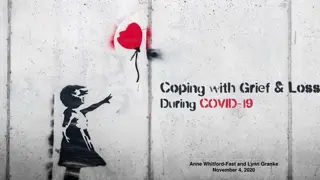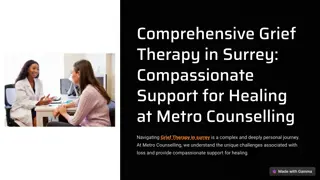Navigating Grief and Finding Meaning
Grief is a natural response to loss that can be both passive and active. It is essential to understand the differences between grief and mourning, the various forms of loss people experience, and how to cope with them. This journey involves accepting the realities of death, honoring the memory of loved ones, and discovering new aspects of self-identity. Through it all, finding meaning in the midst of grief can provide a sense of purpose and healing.
Download Presentation

Please find below an Image/Link to download the presentation.
The content on the website is provided AS IS for your information and personal use only. It may not be sold, licensed, or shared on other websites without obtaining consent from the author.If you encounter any issues during the download, it is possible that the publisher has removed the file from their server.
You are allowed to download the files provided on this website for personal or commercial use, subject to the condition that they are used lawfully. All files are the property of their respective owners.
The content on the website is provided AS IS for your information and personal use only. It may not be sold, licensed, or shared on other websites without obtaining consent from the author.
E N D
Presentation Transcript
Good Words for Grieving Grief hurts. Mourning helps. Beth L. Hewett, PhD, CT, CEOLS beth@goodwordsforgrieving.com 443-904-6424
Wearing several hats (your own experiences AND coworker, supervisor, health care giver to patients, clients, and residents): 1. Learn how grief and mourning differ. 2. Consider who and what people grieve in the workplace. 3. Connect these to your own health care setting. 4. Put something new into practice.
COVID-19: Sometimes multiple family members, friends, and coworkers died or were physically affected. Other Deaths: COVID-by-proxy Health (e.g., heart attacks, cancer, stroke) Accidents (e.g., transportation-related, falls, drowning) Natural (e.g., hurricane, tornado, fire) Violent (e.g., murder, gunshot, knifing) Pets and/or working animals
Relationships with patients and their families Working at home (returning to the office) Home schooling (returning to school) Caregiving (lack of ability to see sick or elderly) & caregiving fatigue Job, economic, or food insecurity
Other relationships or connections Support systems (e.g., daycare) Sense of safety and security in the world Increased awareness of own mortality Time Expectations for ourselves, others, or world
Passive Internalized emotional response to loss Asks us to slow down and give it attention Natural, normal, necessary All encompassing of the body, soul, and spirit Loss of the capacity for joy and pleasure
Active Externalized, social response to loss and grief Requires time to do its work Natural, normal, necessary but discouraged in our society Re-energizes the body, soul, and spirit
Accept the realities of the death/loss. Let yourself feel the pain of the loss. Remember the person who died. Develop a new self-identity. Find meaning inside you. Attend to your spiritual needs. Stay connected with others.
We can take from the past what we need for the future. Remember Get information Integrate Akan: Go back & fetch it!
Bereaved people have a high need to be understood, but a low capacity to be understanding. Therefore, workplace (& home) problems abound.
Talking and listening with Loved ones and friends Grief groups Grief coach or counselor Mourning activities (see More Good Words & Supporting a Grieving Workforce) Funerals & Memorials Honoring what is past Speaking the deceased s name Writing, drawing, planting, creating
Living the Sankofa Finding humor where we can Feeling and expressing emotions as they arise Good self care Hugging (when/if safe) Knowing we re not crazy Having hope
Possibility & Courageous partnerships to create change
What new concept have you learned about mourning that has an immediate use within your workplace?
FREE & CONFIDENTIAL MENTAL HEALTH SUPPORT FOR MARYLAND LONG-TERM HEALTH CARE EMPLOYEES Maryland COVID-19 Crisis Support Program Free mental health services include: Individual Counseling Self-care / Stress Management Education Management Consultation for sustaining employee wellbeing Group Support for specific workgroups /shifts Critical Incident Debriefings for specific traumatic events Wellness / Stress Management facilitated discussions for all employees Bereavement Coaching Get Help Now To receive mental health services for yourself or your organization visit: bit.ly/marylandcovidsupport If you have an urgent request, please contact MIEMSS at 1-800-648-3001. For general inquiries email miemss.crisisresponse@maryland.gov.
Cacciatore, J. (2017). Bearing the unbearable: Love, loss, and the heartbreaking path of grief. Wisdom Publications. Barbash, T. (2006). A tale of renewal: For the 9/11 survivors of Cantor Fitzgerald, working to rebuild their firm has been the key to healing. Business Week, p. 84. Charles-Edwards, D. (2009). Empowering people at work in the face of death and bereavement. Death Studies 33, 420 436. Hewett, Beth L. (2014). More good words: Practical activities for mourning. Westbow Press. Hewett, B. L., & Ottenstein, R. (2021). Supporting a Grieving Workforce. Good Words Publishing. Mallick, M. (2020). It s time to rethink corporate bereavement policies. Harvard Business Review. https://hbr.org/2020/10/its-time-to-rethink-corporate-bereavement-policies Mitchell, Jeffrey, T. (2017). Group crisis intervention, 5th edition, revised. International Critical Incident Stress Foundation, Inc. Thompson, Neil, & Lund, Dale A. (2009). Loss, grief, and trauma in the workplace. Taylor & Francis Group. Peticca-Harris, A. (2019). Managing compassionately? Managerial narratives about grief and compassion. Human Relations, 72(3), 588 612. https://doi.org/10.1177/0018726718779666d Rocco, T. S., & Shuck, B. (2019). Death and dying: Grief, compassion, and workplace responses. New Horizons in Adult Education and Human Resources Development, 32(1), 1-4. Tyler, Kathryn. (Sep 2003). Helping employees cope with grief. HRMagazine, 48(9), 54-58. Weller, Francis. (2015). The wild edge of sorrow: Rituals of renewal and the sacred work of grief. North Atlantic Books. Wolfelt, Alan D. (2003). Understanding your grief: Ten essential touchstones for finding healing and hope. Companion Press.
This activity has been planned and implemented in accordance with the Essential Areas and policies of the Accreditation Council for Continuing Medical Education (ACCME) through the joint providership of MedChi, The Maryland State Medical Society and the Behavioral Health Administration of the Maryland Department of Health. MedChi is accredited by the ACCME to provide continuing medical education for physicians. CMEs will be available at no cost, as will Participant Certificates, which for other disciplines may qualify for CEUs or other continuing education credit, although these are not approved for CEUs by the Maryland Board of Social Work Examiners. Participants should check with their certifying organizations to see how these would apply. MedChi designates this webinar educational activity for a maximum of 1 AMA PRA Category 1 Credits . Physicians should claim only the credit commensurate with the extent of their participation in the activity, as should other disciplines who claim credit for Participant Certificates. For CME/Participant Certificate questions please contact Sherrie Noonan at sherrie.noonan@maryland.gov. Webinars jointly sponsored by the Behavioral Health Administration and MedChi.
Presenters and Planners: Aliya Jones, MD and Steve Whitefield, MD have reported no relevant financial relationships to disclose. Beth Hewett, PhD and Dennis Dupont have reported no relevant financial relationships to disclose. MedChi CME Reviewers: The reviewers from the MedChi Committee On Scientific Activities (COSA) for this activity have reported no relevant financial relationships to disclose. Webinars jointly sponsored by the Behavioral Health Administration and MedChi.
